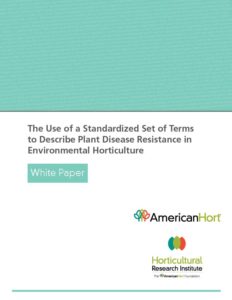What Does Plant Disease Resistance Really Mean?
 Disease resistance and tolerance to abiotic stresses, such as drought and cold exposure in greenhouse-grown plants, contribute greatly to plant health and ultimately to the success of the horticulture industry. As more new plants are expected to be released targeting disease and/or abiotic stress management, the industry will be faced with how to best represent these traits to customers and set performance expectations.
Disease resistance and tolerance to abiotic stresses, such as drought and cold exposure in greenhouse-grown plants, contribute greatly to plant health and ultimately to the success of the horticulture industry. As more new plants are expected to be released targeting disease and/or abiotic stress management, the industry will be faced with how to best represent these traits to customers and set performance expectations.
In many cases, the terms “resistance” and “tolerance” are used interchangeably. And oftentimes, resistance is mistakenly thought to equal immunity.
AmericanHort and its research foundation, the Horticultural Research Institute (HRI), are dedicated to unifying the industry to cultivate successful businesses and help enhance lives through the benefits of plants. AmericanHort relies on stakeholder input to drive its focus and efforts, including the recent industry-initiated movement to standardize the terms used as marketing tags on newly released plant material in reference to specific diseases and/or abiotic stresses.
At the request of industry representatives, AmericanHort has led an effort to explore industrywide adoption of specific terms to be used in the event of a new plant release when describing disease resistance and/or tolerance to abiotic stresses to help avoid unsubstantiated and misleading claims.
“It’s a good idea for the whole industry to use the same words to describe a plant’s response to stress and to clarify the specific pathogen or agent tested,” says Jean-Marc Versolato, Production Manager, Plant Health Department at Bailey, who participated in the process. “This is useful so that the end customer understands the claim being made, and there is no ambiguity in a plant’s resistance or tolerance to a stress. It becomes a truer statement and no longer misleads the customer into thinking a plant is resistant to all sorts of problems.”
__________________________________________________________________________________
Let us know what you think in the comments box below, or in this discussion thread on Greenhouse Grower Community!
__________________________________________________________________________________
A working group made up of the research community and industry breeders advised a set of clear definitions for the terms immunity, high or intermediate resistance, susceptibility, and tolerance to be used industrywide going forward. Disease specifics should be included on marketing claims. For example, a tag on an impatiens plant should state “High Resistance to Impatiens Downy Mildew” as opposed to “High Resistance to Disease.”
Shannon Carmody, Plant Pathologist at Ball Horticultural Company, says the development of downy mildew-resistant impatiens started a conversation internally at Ball Horticultural about how to use accurately disease resistance language in breeding, product development, and marketing for ornamental crops.
“We look forward to working with other industry stakeholders to improve clarity and consistency for our customers,” Carmody says.
A full whitepaper is available on the HRI website. AmericanHort encourages all breeders and those involved in new plant introductions within environmental horticulture to follow this guidance.










